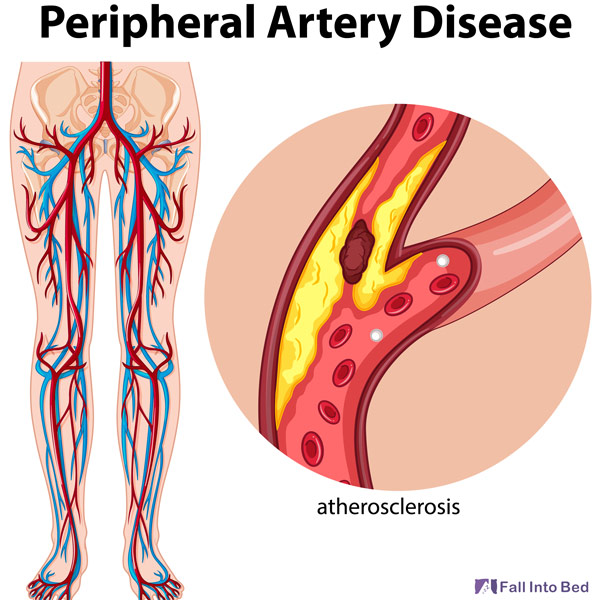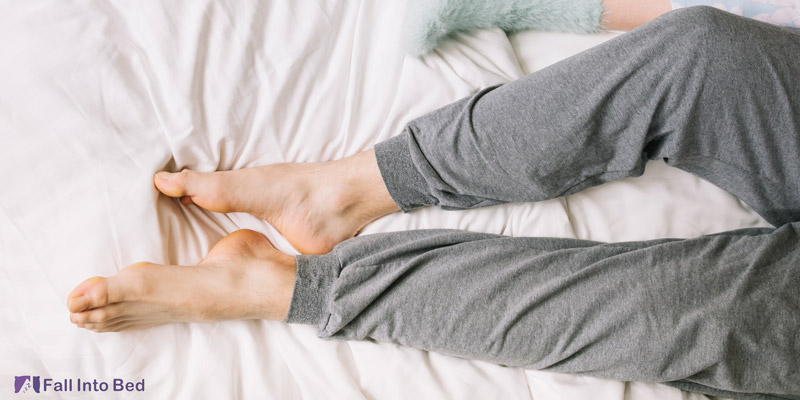If you or your loved ones suffer from peripheral artery disease and have a hard time sleeping due to the pain and discomfort, you should think about changing your sleep position. In this article you can learn more about the best sleeping positions for peripheral artery disease and tips to improve your sleep.
Understanding peripheral artery disease (PAD)
PAD is a condition where the arteries (the blood vessels that carry blood from your heart to the rest of your body) become narrowed or blocked due to a build-up of fatty deposits in the arteries (atherosclerosis). This disease mainly affects the arteries in your legs.
This happens because fatty stuff called plaque builds up inside the blood vessels. Imagine your blood vessels like pipes that can get clogged over time. And People who smoke, have diabetes, high blood pressure, or high cholesterol are more likely to get PAD.

Signs and symptoms of peripheral artery disease
Many people with PAD have no symptoms at all. But here are the most common signs of peripheral artery disease:
- Leg pain: leg pain or medically referred to as claudication is the most common symptom and usually happens during walking and will get better with a few minutes of rest. In more severe cases, the pain won’t go away even with rest. Both legs are affected at the same time, though the pain in one leg is usually worse.
- Leg numbness and weakness
- Coldness in the lower leg due to the reduced blood flow
- Sores or wounds on the feet and legs that do not heal
- Loss of hair in the area
- Shiny and tight-looking skin
The effect of PAD on sleep
peripheral artery disease can significantly impact sleep, especially if the disease is in its advanced level. The main ways PAD can affect sleep are:
Pain at rest
Like we mentioned, as this disease progresses, the pain in the legs can stay during rest and hence sleep. This “rest pain” usually gets worse at nights, making it more difficult to fall asleep.
Cramps
Nocturnal leg cramps can also wake you up from sleep. the cramps are caused by the poor blood flow to your lower extremities.

Position-dependant pain
Sleeping position is very important in peripheral artery disease. Positions like elevating the leg or lying flat can reduce the blood flow to your feet and increase the pain.
Best sleeping positions for peripheral artery disease
Elevating your Head
Sleeping on the back while slightly elevating your head is a recommended sleeping position for peripheral artery disease. Elevating the head can help with the circulation and the blood flow in your legs. If you experience pain and cramps during the night, this position can save you.
Elevating the legs
Elevating the legs does the opposite of elevating the head and it’s not recommended for everyone with PAD. putting your legs in a higher position that your heart can prevent blood pool in your legs and reduce swelling and pain.
However, this position also reduces the blood flow to your legs and feet. So, if you suffer from rest pain and cramps, this position is not recommended.
Sleeping on the back
As it was mentioned, sleeping on the back with head elevated is one of the best positions. Also, this position can reduce lower back pain.
However, this position will narrow the airways and can worsen breathing problems. like sleep apnea and snoring. So, sleeping on the back is not a recommended position if you have breathing problems.

Side sleeping
For those of you who have PAD and breathing problems during sleep, sleeping on the side is a great option. You can also place a pillow between your knees to keep your spine aligned to prevent knee and back pain. You can check the differences between sleeping on the right side and left side to make sure it doesn’t interfere with any other condition.
Sleeping positions you should avoid with peripheral artery disease
Sleeping on the stomach
Stomach sleeping can put pressure on the chest and heart and interfere with circulation. Also, in people with swelling legs, it’s better to have their legs slightly elevated. Whereas in this position, it’s the opposite.
Sleeping with legs crossed
This position can prevent blood from freely flowing in your legs and cause pain and cramps during sleep.
Overview of sleeping positions
| Sleeping position | Pros | Cons | Good for PAD |
|---|---|---|---|
| Elevating the head | -helps with blood circulation -sooths muscle tension -reduces acid reflux | ✔️ | |
| Elevating the legs | -reduces swelling and discomfort -prevents blood pooling | –reduces blood flow to the legs -increases pain in the legs | MAYBE |
| Sleeping on the back | -good for lower back pain -beneficial for knee pain and IT band syndrome -recommended for PAD if the head is elevated | -bad for breathing problems | ✔️ |
| Side sleeping | -beneficial for breathing problems -good for lower back pain -recommended position during pregnancy | -can potentially cause shoulder and neck pain | ✔️ |
| Sleeping on the stomach | -potentially good for breathing problems | -bad for lower back pain | ❌ |
| Sleeping with legs crossed | -decreases blood flow to lower extremities | ❌ |
Tips to manage PAD for a better sleep
- See a doctor; if you have constant pain and other symptoms PAD, make sure you consult with a doctor to get information and detail on what you need to do.
- Change in lifestyle; a health lifestyle can significantly help with the symptoms. A health diet is essential to keep the blood pressure normal. Monitoring blood sugar for potential diabetes and quitting smoking can help with PAD symptoms and your overall health.
- Pain management; after consulting with your doctor, using painkillers is helpful for sleep
- Warm compresses; Applying a warm compress to your legs before bed or keeping your legs warm with dry socks can help improve blood flow and reduce pain.

Sleeping with peripheral artery disease can be challenging, especially in more severe cases. By gathering more information about this condition, its symptoms and sleeping positions that can reduce your pain and discomfort, you can improve your sleep quality.
Sweet painless dreams!








